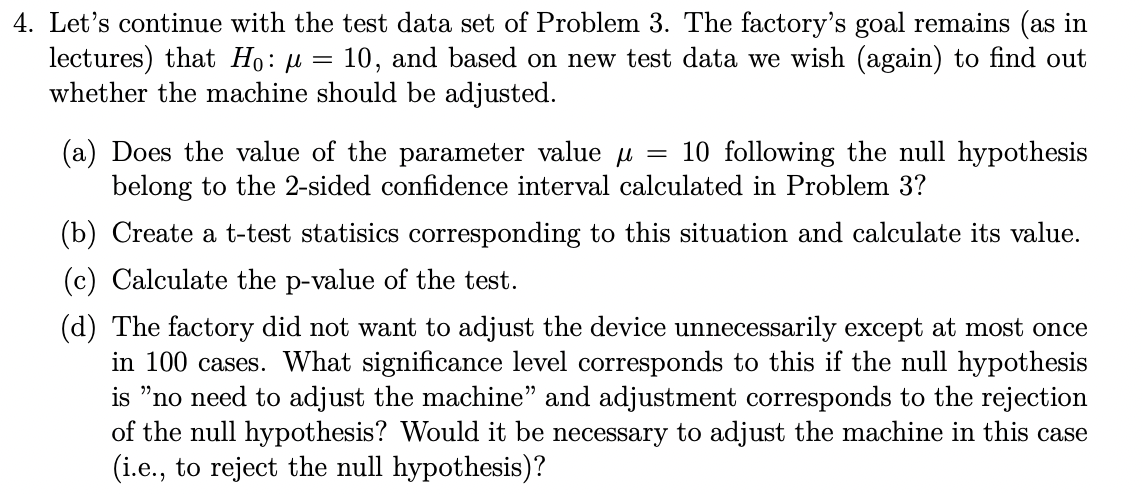4. Let's continue with the test data set of Problem 3. The factory's goal remains (as in lectures) that Ho: μ = 10, and based on new test data we wish (again) to find out whether the machine should be adjusted. 10 following the null hypothesis (a) Does the value of the parameter value μ = belong to the 2-sided confidence interval calculated in Problem 3? (b) Create a t-test statisics corresponding to this situation and calculate its value. (c) Calculate the p-value of the test. (d) The factory did not want to adjust the device unnecessarily except at most once in 100 cases. What significance level corresponds to this if the null hypothesis is "no need to adjust the machine" and adjustment corresponds to the rejection of the null hypothesis? Would it be necessary to adjust the machine in this case (i.e., to reject the null hypothesis)?
4. Let's continue with the test data set of Problem 3. The factory's goal remains (as in lectures) that Ho: μ = 10, and based on new test data we wish (again) to find out whether the machine should be adjusted. 10 following the null hypothesis (a) Does the value of the parameter value μ = belong to the 2-sided confidence interval calculated in Problem 3? (b) Create a t-test statisics corresponding to this situation and calculate its value. (c) Calculate the p-value of the test. (d) The factory did not want to adjust the device unnecessarily except at most once in 100 cases. What significance level corresponds to this if the null hypothesis is "no need to adjust the machine" and adjustment corresponds to the rejection of the null hypothesis? Would it be necessary to adjust the machine in this case (i.e., to reject the null hypothesis)?
MATLAB: An Introduction with Applications
6th Edition
ISBN:9781119256830
Author:Amos Gilat
Publisher:Amos Gilat
Chapter1: Starting With Matlab
Section: Chapter Questions
Problem 1P
Related questions
Question

Transcribed Image Text:4. Let's continue with the test data set of Problem 3. The factory's goal remains (as in
lectures) that Ho: μ = 10, and based on new test data we wish (again) to find out
whether the machine should be adjusted.
10 following the null hypothesis
(a) Does the value of the parameter value μ =
belong to the 2-sided confidence interval calculated in Problem 3?
(b) Create a t-test statisics corresponding to this situation and calculate its value.
(c) Calculate the p-value of the test.
(d) The factory did not want to adjust the device unnecessarily except at most once
in 100 cases. What significance level corresponds to this if the null hypothesis
is "no need to adjust the machine" and adjustment corresponds to the rejection
of the null hypothesis? Would it be necessary to adjust the machine in this case
(i.e., to reject the null hypothesis)?
Expert Solution
This question has been solved!
Explore an expertly crafted, step-by-step solution for a thorough understanding of key concepts.
Step by step
Solved in 2 steps

Recommended textbooks for you

MATLAB: An Introduction with Applications
Statistics
ISBN:
9781119256830
Author:
Amos Gilat
Publisher:
John Wiley & Sons Inc

Probability and Statistics for Engineering and th…
Statistics
ISBN:
9781305251809
Author:
Jay L. Devore
Publisher:
Cengage Learning

Statistics for The Behavioral Sciences (MindTap C…
Statistics
ISBN:
9781305504912
Author:
Frederick J Gravetter, Larry B. Wallnau
Publisher:
Cengage Learning

MATLAB: An Introduction with Applications
Statistics
ISBN:
9781119256830
Author:
Amos Gilat
Publisher:
John Wiley & Sons Inc

Probability and Statistics for Engineering and th…
Statistics
ISBN:
9781305251809
Author:
Jay L. Devore
Publisher:
Cengage Learning

Statistics for The Behavioral Sciences (MindTap C…
Statistics
ISBN:
9781305504912
Author:
Frederick J Gravetter, Larry B. Wallnau
Publisher:
Cengage Learning

Elementary Statistics: Picturing the World (7th E…
Statistics
ISBN:
9780134683416
Author:
Ron Larson, Betsy Farber
Publisher:
PEARSON

The Basic Practice of Statistics
Statistics
ISBN:
9781319042578
Author:
David S. Moore, William I. Notz, Michael A. Fligner
Publisher:
W. H. Freeman

Introduction to the Practice of Statistics
Statistics
ISBN:
9781319013387
Author:
David S. Moore, George P. McCabe, Bruce A. Craig
Publisher:
W. H. Freeman